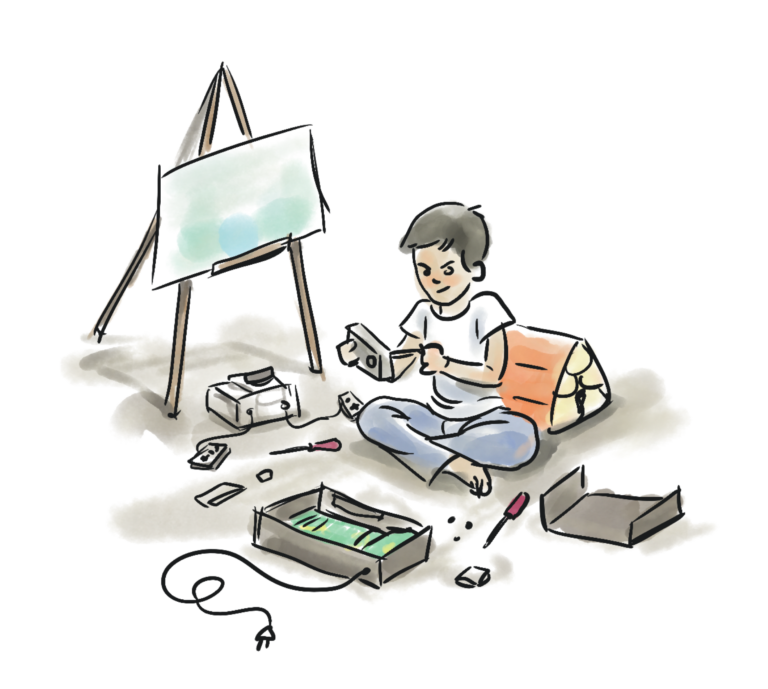A little about myself
Designer, developer, and creative storyteller bridging art and technology

Quiet Rebel in Design
Hi, I’m Nor (naw). For three decades I’ve been the designer who listens closely, questions quietly, and asks the things we sometimes forget: "Does this actually work for people?“
I call myself a Quiet Rebel — not because I like to argue, but because I’ve seen how often design decisions are made on assumption or consensus instead of evidence. My way is different: thoughtful research over gut instinct, lasting impact over loud opinions.
The Rebellion Started Early
Growing up between Lao and American cultures taught me something important: “normal” is just perspective.
In one culture, questioning authority was seen as disrespectful. In the other, staying quiet made people assume you had nothing to add. For a long time, I thought the loudest voices in design meetings must know more.
As a junior designer, I often stayed quiet in big rooms, even when I had ideas. My natural introversion made it easier to listen, take notes, and let others debate. But in 1:1s and smaller groups, I found my voice — and my feedback often shifted the direction of projects.
That taught me something important: being quiet doesn’t mean being passive. It means I take time to think before I speak. And when I do, what I say usually matters.
Over time, I’ve pushed myself to bring that same clarity into bigger rooms. I may never be the loudest voice in a meeting — but I’ve learned I don’t need to be. I’d rather be the voice that moves the conversation forward.
What I Push Back Against
I’ve learned that most UX failures come not from lack of effort, but from chasing consensus instead of clarity. Here are a few things I work to change:
- Design decisions made in boardrooms instead of with real users
- "Best practices” copied without context
- Accessibility treated as a checkbox instead of a commitment
- Personas that read like creative writing but don’t match actual behavior
I believe design should prove itself in practice, not in presentation decks.
30 Years of Quiet Revolution
- Pattern Recognition: Spotting where systems will break before launch, because I’ve seen the same pitfalls many times
- Cultural Translation: Making tools work across different thinking styles and cultural contexts
- Evidence-Based Rebellion: Challenging design orthodoxy with data, not opinions
- Systems Thinking: Connecting user needs, business reality, and technical constraints into one clear path

Origin Story
I started as a comic illustrator in 1994, telling stories about outsiders and misfits. When the web took off, I traded ink for pixels—but kept the outsider’s perspective that makes systems work for everyone, not just insiders.
Born in Thailand’s Isan region and raised near Chicago, I grew up learning how assumptions about “normal” often exclude the very people products are supposed to serve. My childhood nickname gupkae (gecko) turned into a design philosophy: create solutions that stick, helping people avoid slipping through systemic cracks.
Since then, I’ve brought this perspective to e-learning, fintech, dating apps, and enterprise software. At Workday, I help build Canvas—our design system used by thousands of designers. At Barnes & Noble’s Yuzu, I designed digital reading experiences for students. At Zoosk, I reshaped dating profiles to spark more meaningful connections.
Beyond the Day Job
I also write Lao-inspired comics and children’s books—stories that both preserve culture and question assumptions. And I build tools for indie creators, because traditional publishing still leaves too many voices out.
For me, these aren’t side hobbies. They’re proof that my quiet rebel approach can work anywhere—design, storytelling, or systems of any kind.
Good systems prove themselves through user success, not presentation polish. I’d rather be quietly right than loudly wrong.
Ready to Join the Rebellion?
For Companies: If your design system leans more on assumption than on evidence, I can help you shift toward what actually works. I partner with teams who want products that survive real-world use, not just earn applause in the boardroom.
For Individuals: Whether you’re shaping your personal brand or learning to communicate your value, I help people find their authentic voice in a world that often rewards volume over meaning.
I don’t do design theater or brand fiction. I build systems and stories that work for the people too often overlooked.
Let’s start a quiet rebellion—together.
